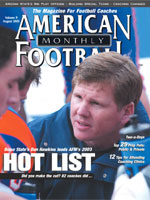AMERICAN FOOTBALL MONTHLY THE #1 RESOURCE FOR FOOTBALL COACHES
Article CategoriesAFM Magazine
|
Helmet Fitting: The Perfect Fit16 steps to find the right helmet for your player\'s safetyby: AFM Editorial Staff © More from this issue In today’s environment, a Football Coach must be proficient at more than organizing practices and teaching football skills. He must not only coach the football team, he must run the football program. This entails selecting, ordering, sizing, issuing and fitting the protective equipment. The proper fitting of helmets can be a time-consuming process, however, it is very critical to a properly run football program. Equipment needs to be “issued and fit,” not merely “handed out.” Schedule and allow time for this very integral part of your program. Don’t shortchange your athletes. Proper fit is the key to head protection and player comfort. The goal is a cus....The full article can only be seen by subscribers. Subscribe today!
|
|
|||||||
| HOME |
MAGAZINE |
SUBSCRIBE | ONLINE COLUMNISTS | COACHING VIDEOS |
Copyright 2025, AmericanFootballMonthly.com
All Rights Reserved





